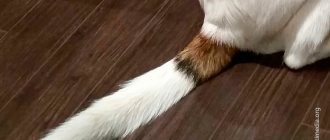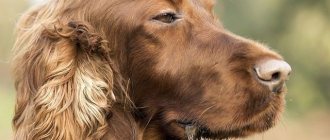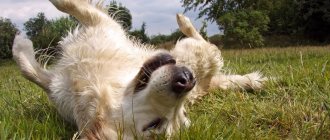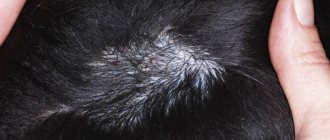What do we have in common with our four-legged friends?
For each type of animal, the tail performs its own functions. In kangaroos it is a support when jumping. Cows need a tail to escape annoying insects.
Maybe it will even be news to someone that we humans also have a tail. No, not among those primitive ape-men, but precisely among us, the modern inhabitants of the Earth. Yes, yes, at an early stage of its development, the human embryo boasts a small tail, which grows when the spine is formed. This tail subsequently stops developing and turns into a tailbone. Therefore, it is worth noting that it turns out that we and our four-legged friends have a lot in common.
Right or left?
An interesting experiment was conducted in Italy. The control group, consisting of 30 domestic dogs of different breeds, was placed in enclosures equipped with 24-hour surveillance cameras. The role of the cameras was reduced to tracking the direction of the tail wagging.
When the experiment participants got used to their temporary homes, each of them was shown four different types of stimuli:
- An owner whom the dog has not seen for some time.
- An unfamiliar and neutral-minded person.
- A cat.
- A dominant, unfamiliar dog.
Why do you need a tail?
From the point of view of the physiological characteristics of the animal, the tail is an important part of the spine. It regulates muscle balance, maintains normal spinal cord pressure and is responsible for the timely supply of nerve impulses. In addition, the tail serves as a balance during movement and helps the animal maintain balance. This is a kind of control lever.
You've probably noticed a fast running dog. The tail is constantly involved in balancing. And when a dog swims, the tail is perpendicular to the animal's body, helping to keep the body parallel to the bottom and keep it afloat.
Yes, of course, a four-legged animal without a tail can easily run, jump and jump. Only his body will no longer have the same hardness and maneuverability as it would have if the animal had a tail. Also, in cold weather, dogs curl up and cover their nose with their fluffy tail so that it does not freeze.
The tail is a mood indicator
Many dog owners believe that a dog's tail is an indicator of the mood of their four-legged pets. And, with the help of movements of such a tail, the dog shows us its emotions, this is how it “speaks” to us. Although, if a dog could really talk, then, as an old English proverb says, people would lose their last friends. To prevent this from happening, the dog is silent (occasionally barks or even howls), and only moves its tail. But dogs whose tails are docked are deprived of this opportunity.
Why do dogs have their tails docked?
The tails of some dog breeds are docked at a very young age (from 1 to 3 days), until the tail cartilages have become stronger and ossified. Sometimes docking is simply due to necessity. For example, some herding dog breeds that guard herds of cows or sheep have their tails and ears docked so that they are not accidentally confused with a wolf.
But, as a rule, these days, dogs have their tails docked to meet breed standards. Before having their tail docked, every owner of a four-legged dog should know that dogs with docked tails are often developmentally delayed, get sick more often, and start running later. Well, if you can’t do without docking, you still need to not cut the tail at the root, but leave at least 2 caudal vertebrae.
Now many kennel clubs are against tail docking unless it is necessary for life. Therefore, if there is no particular need for docking, try, if possible, to preserve this part of your pet’s body!
Do dogs control the movement of their tail?
Contents hide
Instinct or learned behavior. Let's look at very small newborn puppies. No, they can't wag their tails. This skill comes to them a little later, as they grow older, when they become more mobile, tinker and play with their mother and brothers and sisters. This is why behaviorists tend to believe that a puppy learns to wag its tail by watching other dogs. But babies don’t just wag their tail: in moments of danger, for example, they hide it between their legs, etc. Most likely, it is a matter of both innate instinct and learned behavior patterns. Perhaps certain innate instincts have simply evolved over time. One way or another, during the period of growing up and active socialization, puppies begin to communicate with their relatives - fairly “experienced” dogs. From them they learn the secrets of canine communication, expand their own vocabulary of “body language,” mastering complex and bizarre tail movements depending on their condition.
Can a dog control the movement of its tail? From an anatomical point of view, the tail is an extension of the dog's spine. In turn, it consists of muscles and bones, which allow it to move in the “right” direction. The dog can actually control the movements of both the entire tail (including the base) and its tip. However, it should be emphasized that the lower part of the tail is not controlled by the dog at its own discretion.
What can and can a dog do? Raise and lower the tail, make it wag from side to side. Take a closer look: the dog wagged and wagged its tail, and then suddenly stopped. Strong evidence for the assertion that the position of the tail is tightly controlled by the owner. But just try to intervene yourself and arbitrarily stop your pet’s tail - it’s unlikely that anything will work. Most likely, the animal’s brain sends some control signals depending on its mood and condition. Thus, we can draw an important conclusion: the tail is set in motion by the dog itself when it “wishes” it. So, pets really control their tails!
How to interpret the movements of the tail of our pets? We do not recommend being captured by common stereotypes. Something like “A dog wagging its tail means it is happy.” Please consider your pet's tail movements in the context of the overall situation and circumstances. Try to understand the whole picture of what is happening, in all the details. So, depending on the specific situation, a wagging tail can indicate simple curiosity (interest), and a readiness to defend itself, and as a response to some external threats.
A dog's body language can be compared to an open encyclopedia book, which you can always open and start reading from any page. The dog itself will never act as a teacher. But the lesson given to the owner will definitely ask!
Original Post : Do Dogs Consciously Control Their Tail Wags? Source: pets4yjmes.co.uk Photo: pixabay.com
Tail as a communication tool and mood indicator
The tail of a quadruped also performs the function of communication. It is an indicator of mood. If a dog owner understands his pet well, then by the tail he can easily determine what mood his four-legged friend is in. And this helps a lot in building relationships.
Not all tail movements mean friendly and happy. Some movements warn of aggression and dominance. And, in order to avoid conflicts with your four-legged one, let’s look at what movements express certain emotions or the mood of the tailed one:
- A quickly wagging, high-raised tail indicates that the dog is friendly. He is happy to see you and wants to play with you.
- If the dog wags his tail low, this indicates his submission.
- If the tail is straightened at the level of the spine, wagging slightly in different directions, the reaction is ambiguous: the dog is alert, it is waiting, whether to play or bite. Everything depends on you.
- The tail is straightened at the level of the spine, there is no wagging, and the hair on the withers stands up: Who can save himself!
- If the tail is tense, raised high, and the tip is actively wagging, this means that the dog is in charge and is ready to act.
- A tail between your legs means submissiveness, fear or excitement.
This list can be continued endlessly. It is only necessary to note that the angle of the tail also matters. More recently, scientists have proven that when expressing joy, a dog wags its tail more to the right, and wagging its tail to the left indicates aggression.
Tail as an odor blocker
In order to deepen the understanding of this important function, it is necessary to first explain such a physiological detail as the paraanal glands. Many owners do not even have an idea about these glands, since it is very difficult for someone inexperienced in zoology to recognize their influence on the dog’s life.
The paraanal glands require periodic care to avoid inflammation.
Externally, the paraanal glands resemble small sacs that are located at the exit from the anus of the animal. Over time, the bags are filled with a specific secretion, which is capable of emitting its own individual smell. This smell is an element of a complex system of interaction between dogs.
Functions of the paraanal glands
The paraanal glands acquire the greatest importance during the period of sexual readiness, since they perform the following two important functions:
- notify the hypothetical sexual partner that the individual is ready to mate;
- notify the animal’s rivals about its plans for a partner and its readiness to fight.
The anal glands are an important tool in canine communication.
The smell emanating from the secretion can either actively spread or be drowned out - it all depends on the dog’s intentions and mood. By actively waving its tail, the animal uses it as a fan, thanks to which the smell of the secretion spreads faster, thereby spreading information about the presence of the dog. If a dog does not want to be recognized and participate in any communication with its relatives, it deliberately presses its tail to hide its presence.
As a rule, acquaintance with the paraanal glands occurs when they become inflamed in a dog and require treatment. You can read below about how to avoid this painful phenomenon for your dog and learn how to flush these glands.
Cleaning the dog's anal glands











